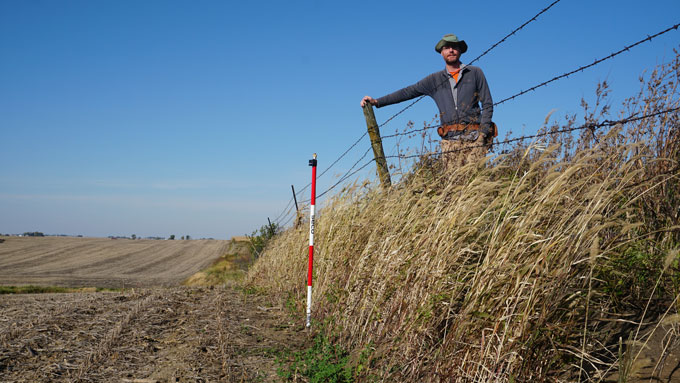With soils rich for cultivation, most land in the Midwestern United States has been converted from tallgrass prairie to agricultural fields. Less than 0.1 percent of the original prairie remains.
This shift over the last 160 years has resulted in staggering — and unsustainable — soil erosion rates for the region, researchers report in the March Earth’s Future. The erosion is estimated to be double the rate that the U.S. Department of Agriculture says is sustainable. If it continues unabated, it could significantly limit future crop production, the scientists say.
In the new study, the team focused on erosional escarpments — tiny cliffs formed through erosion — lying at boundaries between prairie and agricultural fields (SN: 1/20/96). “These rare prairie remnants that are scattered across the Midwest are sort of a preservation of the pre-European-American settlement land surface,” says Isaac Larsen, a geologist at the University of Massachusetts Amherst.
At 20 sites in nine Midwestern states, with most sites located in Iowa, Larsen and colleagues used a specialized GPS system to survey the altitude of the prairie and farm fields. That GPS system “tells you where you are within about a centimeter on Earth’s surface,” Larsen says. This enables the researchers to detect even small differences between the height of the prairie and the farmland.
At each site, the researchers took these measurements at 10 or more spots. The team then measured erosion by comparing the elevation differences of the farmed and prairie land. The researchers found that the agricultural fields were 0.37 meters below the prairie areas, on average.

This corresponds to the loss of roughly 1.9 millimeters of soil per year from agricultural fields since the estimated start of traditional farming at these sites more than a century and a half ago, the researchers calculate. That rate is nearly double the maximum of one millimeter per year that the USDA considers sustainable for these locations.
There are two main ways that the USDA currently estimates the erosion rate in the region. One way estimates the rate to be about one-third of that reported by the researchers. The other estimates the rate to be just one-eighth of the researchers’ rate. Those USDA estimates do not include tillage, a conventional farming process in which machinery is used to turn the soil and prepare it for planting. By disrupting the soil structure, tilling increases surface runoff and erosion due to soil moving downslope.
Larsen and colleagues say that they would like to see tillage incorporated into the USDA’s erosion estimates. Then, the USDA numbers might better align with the whopping 57.6 billion metric tons of soil that the researchers estimate has been lost across the entire region in the last 160 years.
This massive “soil loss is already causing food production to decline,” Larsen says. As soil thickness decreases, the amount of corn successfully grown in Iowa is reduced, research shows. And disruption to the food supply could continue or worsen if the estimated rate of erosion persists.
Not everyone is convinced that the average amount of soil lost each year has remained steady since farming in the region started. Much of the erosion that the researchers measured could have been caused in the earlier histories of these sites, dating back to when farmers “began to break prairies and/or forests and clear things,” says agronomist Michael Kucera.
Perhaps current erosion rates have slowed, says Kucera, who is the steward of the National Erosion Database at the USDA’s National Soil Survey Center in Lincoln, Neb.
To help reduce future erosion, farmers can use no-till farming and plant cover crops, the researchers note. By planting cover crops during off-seasons, farmers reduce the amount of time the soil is bare, making it less vulnerable to wind and water erosion.
In the United States, no-till and similar practices to help limit erosion have been implemented at least sometimes by 51 percent of corn, cotton, soybean and wheat farmers, according to the USDA. But cover crops are only used in about 5 percent of cases where they could be, says Bruno Basso, a sustainable agriculture researcher at Michigan State University in East Lansing who wasn’t involved with the study. “It costs $40 to $50 per acre to plant a cover crop,” he says. Though some government grant funding is available, “the costs of cover crops are not supported,” and there is a need for additional incentives, he says.
To implement no-till strategies, “the farmer has to be a better manager,” says Keith Berns, a farmer who co-owns and operates Green Cover Seed, which is headquartered in Bladen, Neb. His company provides cover crop seeds and custom seed mixtures. He has also been using no-till practices for decades.
To succeed, farmers must decide what particular cover crops are most suitable for their land, when to grow them and when to kill them. Following these regimens, which can be more complicated than traditional farming, can be “difficult to do on large scales,” Berns says.
Cover crops can confer benefits such as helping farmers repair erosion and control weeds within the first year of planting. But it can take multiple years for the crops’ financial benefits to exceed their cost. Some farmers don’t even own the land they work, making it even less lucrative for them to invest in cover crops, Berns notes.
Building soil health can take half a decade, Basso says. “Agriculture is really always facing this dilemma [of] short-sighted, economically driven decisions versus longer-term sustainability of the whole enterprise.”



